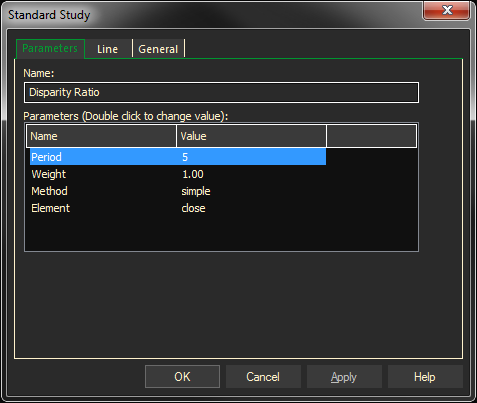The disparity ratio is a measure of the divergence of a price from a moving average. If the 26-period disparity is +15%, for example, it means that the instrument price at that point is 15% above the 26-period moving average. If the disparity is -15%, the price is 15% below the moving average.
Parameters:
Symbol — data source symbol.
Period — moving average period.
Weight — moving average weighting factor.
Method — moving average calculation method: (Standard, Exponential, Weighted, Running)
Element — price field to use for calculation (Close, High, Low, Open)

Adding the Disparity Ratio Study to a Chart
- Click on the f(x) Studies docked pane window.
- Click on the plus sign to expand the fx Standard.
- Find the Disparity Ratio study, drag and drop it on the chart
Or
- Right-Click on a blank part of the chart and select ADD STUDY.
- The Add Study dialog box will open.
- Under Data Source, you will find a list of charts and studies in the window. Select the one on which you want the new study to be based.
- Under Studies, select the study you want to add to the window. The library of studies will include standard ProphetX studies plus those that you have created. The Most Recent will include studies that you have previously used.
- Under Add To, select the stack you want to add the study to, or select <New Stack> to create a new stack for the study.
- Click OK to exit.
Changing Parameters
- Do either of the following to change the parameters:
- For an existing study on a chart, right-click on the study and select PROPERTIES on the pop-up menu, and modify as necessary
- Right-click on the study name listed in the f(x) docked pane and make the changes in the displayed dialog. Update will save the parameters permanently.